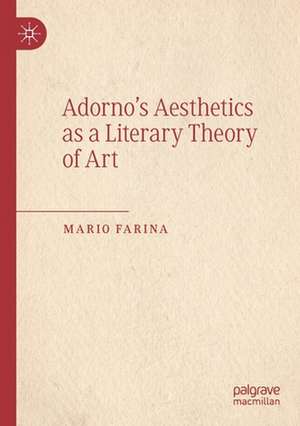Adorno’s Aesthetics as a Literary Theory of Art
Autor Mario Farinaen Limba Engleză Paperback – 24 iun 2021
| Toate formatele și edițiile | Preț | Express |
|---|---|---|
| Paperback (1) | 580.17 lei 6-8 săpt. | |
| Springer International Publishing – 24 iun 2021 | 580.17 lei 6-8 săpt. | |
| Hardback (1) | 585.57 lei 6-8 săpt. | |
| Springer International Publishing – 24 iun 2020 | 585.57 lei 6-8 săpt. |
Preț: 580.17 lei
Preț vechi: 682.55 lei
-15% Nou
Puncte Express: 870
Preț estimativ în valută:
111.03€ • 114.70$ • 92.40£
111.03€ • 114.70$ • 92.40£
Carte tipărită la comandă
Livrare economică 25 martie-08 aprilie
Preluare comenzi: 021 569.72.76
Specificații
ISBN-13: 9783030452834
ISBN-10: 3030452832
Pagini: 237
Ilustrații: XIX, 237 p.
Dimensiuni: 148 x 210 mm
Greutate: 0.31 kg
Ediția:1st ed. 2020
Editura: Springer International Publishing
Colecția Palgrave Macmillan
Locul publicării:Cham, Switzerland
ISBN-10: 3030452832
Pagini: 237
Ilustrații: XIX, 237 p.
Dimensiuni: 148 x 210 mm
Greutate: 0.31 kg
Ediția:1st ed. 2020
Editura: Springer International Publishing
Colecția Palgrave Macmillan
Locul publicării:Cham, Switzerland
Cuprins
1. Construction of 'Aesthetics' as Construction of 'The Aesthetic'.- 2. The Philosophy of Music and the Dissolution of the Aesthetic.- 3. Literature and the Reconstruction of the Aesthetic.- 4. Adorno's Philosophy of Literature: A Theory of Literary Interpretation.- 5. Beyond Modernism: The American Postmodern Novel.
Notă biografică
Dr. Mario Farina is Postdoc Fellow in history of philosophy at the University of Florence, Italy, and Adjunct Professor in Aesthetics at the University of Eastern Piedmont, Italy. His research interests include German philosophy, aesthetics and philosophy of literature. He is the author of Critica, simbolo e storia. La determinazione hegeliana dell'estetica (Pisa, 2015).
Textul de pe ultima copertă
This book re-examines Adorno’s aesthetics, developing a new literary approach that aims to unveil hidden elements of Adorno’s thought. Farina proposes to read Adorno’s aesthetics as a literary theory of art, showing its efficacy in its comprehension of the most advanced trends of contemporary literature. As a result, this book provides an image of Adorno’s aesthetics as a complete, satisfying and consistent philosophy of literature, a robust theory which is able to stand its ground in contemporary aesthetic debate. Challenging the prevalent prejudice that defines Adorno’s thought, and especially his aesthetics, as ‘modernist’, Farina argues that Adorno's philosophy of literature shows its value precisely in its application to and comprehension of postmodern literature, such as the works of Thomas Pynchon, Don DeLillo and David Foster Wallace. Precise and compelling, this book provides a new paradigm for understanding Adorno’s theory of artwork, serving as an essential reference for researches investigating the relation between classical critical theory and contemporary art.
Caracteristici
Provides a new paradigm for understanding Adorno’s theory of artwork Provides an image of Adorno’s aesthetics as a complete, satisfying and consistent philosophy of literature Argues that Adorno's philosophy of literature shows its value precisely in its application to and comprehension of postmodern literature
